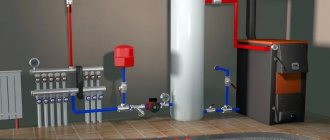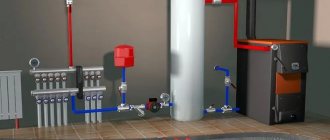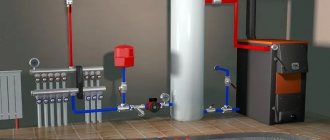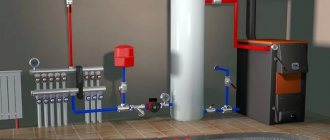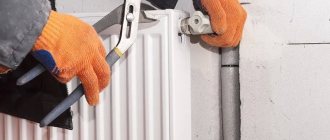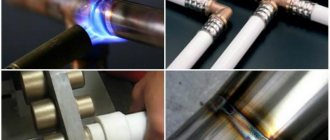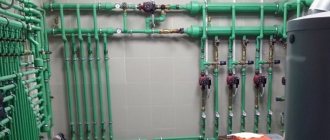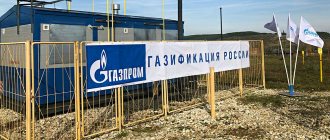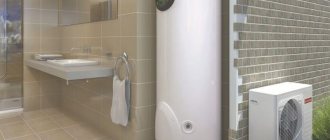A heating device in a private house or country house is vital both for the residents living in it and for the building itself, increasing its service life.
For this purpose, heating is installed in the house, and often it is done with your own hands, using a one-pipe or two-pipe scheme. Moreover, it is necessary to turn on several types of heating, in case of interruptions in one or another type of fuel or emergency failure of the system.
In this article we have covered all the questions related to this topic, here you will find various diagrams and instructions, video lessons, what elements the heating system consists of, how to calculate it and much other useful information.
Methods for connecting the boiler to the heating circuit
The composition of the equipment and the boiler piping directly depends on the selected type of heating circuit, the method of circulation of the coolant and the degree of automation of the process, such as fine-tuning the climate or simply adjusting the heating of the coolant.
The task of the entire strapping complex is:
- Ensure uniform heat distribution throughout the heating circuit.
- Protect people and equipment from any emergency situations and minimize the consequences of a breakdown.
- Reducing the influence of frequency in the operation of a solid fuel boiler, since the main power is released only after the next load of fuel is ignited, while as it burns out, the heat transfer decreases.
How to install heating correctly
In order for a finished heating system with a natural circulation type to function correctly and efficiently, it is important to adhere to certain rules when installing it. In general, the installation diagram looks like this:
In general, the installation diagram looks like this:
- Heating radiators must be installed under the windows, preferably at the same level and maintaining the required indentations.
- Next, install the heat generator, that is, the selected boiler.
- Install the expansion tank.
- The pipes are laid out and the previously fixed elements are joined into a single system.
- The heating circuit is filled with water and a preliminary check for the tightness of the connections is performed.
- The final stage is to start the heating boiler. If everything works correctly, then the house will be warm.
Please pay attention to some nuances:
- The boiler should be located at the lowest point of the system.
- The pipes must be installed with a slope towards the return flow.
- There should be as few turns in the pipeline as possible.
- To increase heating efficiency, pipes with a larger diameter are required.
We hope this article will be useful to you, and you will be able to independently install a heating system without a circulation pump in your country house.
A heating system with natural circulation of liquid is a closed device of the gravitational (gravity) type, which allows you to heat rooms in a private house regardless of the power supply.
This advantage of the design makes it possible to use it in regions with problems or complete absence of a central electrical network. The system is economical, but for its proper functioning you will need to make accurate calculations.
Heating design elements
Most often, houses in the private sector are heated using water heating. The choice for this type of heating falls due to its versatility. The coolant supplies heat to all rooms of the building. And the coolant itself is heated by one of the possible energy carriers. Water boilers allow you to organize a combined heat supply using two or three types:
- pipeline network, which includes fittings and instruments;
- coolant;
- heating devices: contour elements of a “warm floor”, piping the house or radiators.
To regulate the coolant and perform maintenance of the heating network, shut-off and control valves and additional elements are used.
Additionally, the following elements are present:
- expansion tank;
- water circulation pump;
- hydraulic separator;
- buffer tank;
- manifold-distributor;
- direct heating boiler;
- means and automatic devices.
Important! An essential element of water heating is an expansion tank. Other equipment can be installed as needed.
We know from physics that when water heats up, it expands. When the space is closed, the resulting additional volume of liquid has nowhere to go. To ensure that the connections in the network do not break due to excess pressure, an expansion tank is needed. The container that receives excess water is of the membrane type.
To force the coolant to circulate, a pump is installed in the network. If two or more circuits are installed, then the same number of pumping devices are used.
The buffer tank works both as a heat accumulator and as a hydraulic separator. If heating is installed in a cottage or in a building on 2-3 floors, then the circulation circuit is separated from the other elements.
Distribution manifolds are installed in heating networks with heated floors. They are also applicable when radiators are connected using a radial circuit.
A container with a coil (boiler) - in it, water is heated from the coolant for the needs of domestic hot water. To control the temperature and pressure in the network, pressure gauges and thermometers are installed. Automation devices include sensors, temperature regulators, and controllers.
Single-pipe heating circuit
From the heating boiler you need to draw a main line representing a branch. After this action, it contains the required number of radiators or batteries. The line, drawn according to the building designs, is connected to the boiler. The method creates coolant circulation inside the pipe, heating the building completely. The circulation of warm water is adjusted individually.
A closed heating scheme for Leningradka is planned. In this process, a single-pipe complex is installed according to the current design of private houses. At the owner's request, the following elements are added:
- Radiator controllers.
- Thermostats.
- Balancing valves.
- Ball valves.
Leningradka regulates the heating of certain radiators.
Bivalent hybrid heating systems based on heat pumps
A hybrid heating system (bivalent) consists of a main heat source, a peak heater and a buffer storage tank. This system allows you to use the heat pump as efficiently as possible with minimal investment.
Functioning of the bivalent system
As you know, heating equipment is selected according to the heat loss of the room at a minimum outdoor temperature (for Kyiv -22 ° C). This means that the selected boiler must heat your room in the temperature range: from -22 to +8 °C. If we analyze Climatology, it turns out that the number of days in the heating season when the temperature drops below -15 °C is less than 5%. Therefore, it is inappropriate to select a heat pump for the lowest possible outdoor temperature; it is much more profitable to purchase a heat pump of lower capacity and an inexpensive backup heat source (a peak heater - the cheapest electric boiler) that will be activated exclusively at temperatures below the bivalence point (usually -15 °C). The advantage of this system is also the redundancy of the heating system.
Main Pros:
- Heating system redundancy
- Possibility of purchasing a heat pump with lower heating capacity
Main Cons:
No
How much power does a heat pump need?
If you have a new house made of aerated block, insulated with 100-120-150 mm of mineral wool or polystyrene foam (walls and foundation to frost depth), good double-chamber energy-saving double-glazed windows, insulated roof (150-200 mm), insulated floor on the ground (minimum 100 mm), then the heat loss of your home is 50 W/m2 (at -22 °C):
- House 100 m2 – 5 kW
- House 150 m2 -7.5 kW
- House 200 m2 – 10 kW
- House 250 m2 – 12.5 kW
- House 300 m2 – 15 kW
- House 350 m2 – 17.5 kW
- House 400 m2 – 20 kW
- House 450 m2 – 22.5 kW
- House 500 m2 – 25 kW
- Building 1000 m2 - 50 kW
In principle, such body losses can be easily covered by an air-to-water heat pump of the Zubadan series:
- House 100 m2 – 5 kW – PUHZ-SW50VHA
- House 150 m2 -7.5 kW – PUHZ-SHW80VHA
- House 200 m2 – 10 kW – PUHZ-SHW112VHA/PUHZ-SHW112YHA
- House 250 m2 – 12.5 kW – PUHZ-SHW140YHA
- House 300 m2 – 15 kW – PUHZ-SHW140YHA + reserve 3 kW
- House 350 m2 – 17.5 kW – PUHZ-SHW230YKA
- House 400 m2 – 20 kW – PUHZ-SHW230YKA
- House 450 m2 – 22.5 kW – PUHZ-SHW230YKA + reserve 3 kW
- House 500 m2 – 25 kW – PUHZ-SHW230YKA + reserve 5 kW
- Building 1000 m2 - 50 kW - Cascade of 2 heat pumps PUHZ-SHW230YKA + reserve 4 kW
When choosing the power of a heat pump, you should also take into account the power required to heat ventilation, a swimming pool, hot water, etc. Therefore, before purchasing, consult an expert and perform a heat loss calculation.
Emergency options
Every piping scheme must include a circuit in case of emergency situations. His task includes:
— protection against pressure drops;
— protection against temperature increases above the permitted limit;
— prevention of moisture formation.
Safety valve in the harness
Its task is precisely to relieve excess pressure from the system. It is mounted at the boiler outlet separately or as part of a safety group.
Emergency heat exchanger in the solid fuel boiler connection system
Its task is most responsible - to prevent overheating of both the boiler and the system in general. Overheating can happen for 2 reasons:
— too much fuel was loaded into the boiler. The heat received exceeded the demand.
— the electricity was turned off and the pump stopped working.
For normal operation of this circuit, it is also necessary to install a temperature sensor with a valve and a cooling unit in the water supply pipe to the boiler. As soon as the coolant temperature exceeds the maximum allowed, the sensor signals this and provokes the opening of the valve.
After the valve is activated, water begins to fill the cooling unit, reducing the temperature of the main coolant.
Auxiliary heating circuit for a solid fuel boiler
One of the options for cooling the system. Its peculiarity is that you will need to connect a storage tank for the DHW circuit.
This scheme will work as follows: in normal operating mode, the pump will operate, creating a certain pressure. It will prevent the auxiliary circuit from coming into operation. But as soon as the electricity is turned off, the pump will stop working, the pressure will disappear, and the backup circuit will come into operation.
Result: the water temperature in the system will drop to the desired value.
Let’s say right away that this scheme is suitable for absolutely any type of heating system!
This mixer maintains the lowest temperature of the coolant at the inlet to the boiler so that condensation does not form on the walls of the device. what we talked about at the very beginning of the article. Thus, in a solid fuel boiler this is one of the most necessary components!
The mixer is installed on the return pipe using a bypass.
If the temperature in the return pipe is low (below the set value), the thermomixer will provide an influx of hot water.
Wiring of a solid fuel heating boiler, diagram
All heat generators operate on this principle.
They receive the energy necessary for work from various solid fuels. It should be noted that they have some operational features that must be taken into account when connecting such boilers to the heating system. It should be noted that the piping diagram of a solid fuel boiler includes several elements and devices that must be used. so that the heating system operates for a long time.
The wiring diagram for a solid fuel boiler is the necessary devices and elements that together form a single heating system. This heating system includes:
- Boiler.
- Circulation pump.
- Expansion tank.
- Emergency power system.
- Co-mixing system.
- Buffer capacity.
- Emergency circuit
- Corrosion protection system.
- Pressure gauge, drain cock, special valve. It's all collected in one block
- Thermal valve.
- Float valve.
What is the difference between solid fuel boilers
In addition to the fact that these heat sources produce thermal energy by burning various types of solid fuel, they have a number of other differences from other heat generators. These differences are precisely a consequence of burning wood; they must be taken as a given and always taken into account when connecting the boiler to a water heating system. The features are as follows:
- High inertia. At the moment, there are no ways to quickly extinguish a solid fuel fire in a combustion chamber.
- Formation of condensation in the firebox. The peculiarity manifests itself when coolant with a low temperature (below 50 ° C) enters the boiler tank.
Note. The phenomenon of inertia is absent only in one type of solid fuel units - pellet boilers. They have a burner into which wood pellets are fed in doses; after the supply is stopped, the flame goes out almost immediately.
The danger of inertia is the possible overheating of the water jacket of the heater, as a result of which the coolant in it boils. Steam is generated, which creates high pressure, rupturing the body of the unit and part of the supply pipeline. As a result, there is a lot of water in the furnace room, a lot of steam and a solid fuel boiler unsuitable for further use.
A similar situation can arise when the heat generator piping is done incorrectly. After all, in fact, the normal operating mode of wood-burning boilers is maximum; it is at this time that the unit reaches its rated efficiency. When the thermostat reacts to the coolant reaching a temperature of 85 °C and closes the air damper, combustion and smoldering in the firebox still continues. The water temperature rises another 2-4 °C, or even more, before its growth stops.
In order to avoid excess pressure and a subsequent accident, an important element is always involved in the piping of a solid fuel boiler - a safety group, which will be discussed in more detail below.
Another unpleasant feature of the unit operating on wood is the appearance of condensation on the inner walls of the firebox due to the passage of not yet heated coolant through the water jacket. This condensate is not God’s dew at all, since it is an aggressive liquid that quickly corrodes the steel walls of the combustion chamber. Then, having mixed with the ash, the condensate turns into a sticky substance that is not so easy to tear off from the surface. The problem is solved by installing a mixing unit in the piping circuit of a solid fuel boiler.
This coating serves as a heat insulator and reduces the efficiency of a solid fuel boiler.
It is too early to breathe a sigh of relief for owners of heat generators with cast iron heat exchangers that are not afraid of corrosion. Another misfortune may await them - the possibility of destruction of cast iron from temperature shock. Imagine that in a private house the electricity was turned off for 20-30 minutes and the circulation pump driving water through the solid fuel boiler stopped. During this time, the water in the radiators has time to cool down, and in the heat exchanger it has time to heat up (due to the same inertia).
Electricity appears, the pump turns on and directs the cooled coolant from the closed heating system into the heated boiler. Due to a sharp temperature change, the heat exchanger experiences a temperature shock, the cast iron section cracks, and water runs onto the floor. It is very difficult to repair; it is not always possible to replace a section. So even in this situation, the mixing unit will prevent an accident, which will be discussed below.
Emergency situations and their consequences are described not with the aim of scaring users of solid fuel boilers or encouraging them to purchase unnecessary elements of piping schemes. The description is based on practical experience, which must always be taken into account. If the heating unit is connected correctly, the likelihood of such consequences is extremely low, almost the same as with heat generators using other types of fuel.
How to connect a solid fuel boiler
The canonical connection diagram for a solid fuel boiler contains two main elements that allow it to function reliably in the heating system of a private home. This is a safety group and a mixing unit based on a three-way valve with a thermal head and a temperature sensor, shown in the figure:
Note. The expansion tank is not shown here, since it can be located in different places in different heating systems.
The presented diagram shows how to connect the unit correctly and should always accompany any solid fuel boiler, preferably even a pellet one. You can find various general heating schemes anywhere - with a heat accumulator, an indirect heating boiler or a hydraulic arrow, on which this unit is not shown, but it must be there. This is explained in more detail in the video:
The task of the safety group, installed directly at the outlet of the supply pipe of a solid fuel boiler, is to automatically relieve pressure in the network when it rises above a set value (usually 3 Bar). This is done by a safety valve, and in addition to it, the element is equipped with an automatic air vent and a pressure gauge. The first releases the air appearing in the coolant, the second serves to control the pressure.
Attention! It is not allowed to install any shut-off valves on the section of the pipeline between the safety group and the boiler
How the scheme works
The mixing unit, which protects the heat generator from condensation and temperature changes, operates according to the following algorithm, starting from kindling:
- The firewood is just starting to burn, the pump is on, the valve on the side of the heating system is closed. The coolant circulates in a small circle through the bypass.
- When the temperature in the return pipeline rises to 50-55 °C, where the attached remote-type sensor is located, the thermal head, at its command, begins to press the three-way valve stem.
- The valve slowly opens and cold water gradually enters the boiler, mixing with hot water from the bypass.
- As all the radiators warm up, the overall temperature increases and then the valve closes the bypass completely, passing all the coolant through the heat exchanger of the unit.
This piping scheme is the simplest and most reliable; you can easily install it yourself and thus ensure the safe operation of the solid fuel boiler. There are a couple of recommendations regarding this, especially when piping a wood-burning heater in a private house with polypropylene or other polymer pipes:
- Make the section of the pipe from the boiler to the safety group from metal, and then lay plastic.
- Thick-walled polypropylene conducts heat poorly, which is why the surface-mounted sensor will openly lie, and the three-way valve will lag. For correct operation of the unit, the area between the pump and the heat generator, where the copper flask is located, must also be metal.
Another point is the installation location of the circulation pump. It is best for him to stand where he is shown in the diagram - on the return line in front of the wood-burning boiler. In general, you can install the pump on the supply side, but remember what was said above: in an emergency, steam may appear in the supply pipe. The pump cannot pump gases, so if steam gets into it, the circulation of the coolant will stop. This will speed up a possible explosion of the boiler, because it will not be cooled by water flowing from the return.
Way to reduce the cost of strapping
The condensate protection circuit can be reduced in cost by installing a three-way mixing valve of a simplified design that does not require connecting an overhead temperature sensor and thermal head. It already has a thermostatic element installed, set to a fixed mixture temperature of 55 or 60 °C, as shown in the figure:
Special 3-way valve for solid fuel heating units HERZ-Teplomix
Note. Similar valves, which maintain a fixed temperature of mixed water at the outlet and are intended for installation in the primary circuit of a solid fuel boiler, are produced by many well-known brands - Herz Armaturen, Danfoss, Regulus and others.
Installing such an element definitely allows you to save on piping the TT boiler. But in this case, the possibility of changing the temperature of the coolant using a thermal head is lost, and its deviation at the output can reach 1-2 °C. In most cases, these shortcomings are insignificant.
Classification of polypropylene hoses
Depending on the conditions of use, in accordance with GOST (ISO 10508), polypropylene pipes for heating a private house or other facility have 5 classes. The third group of long elements is practically not used in the construction of thermal circuits of buildings.
Fragment of heating made of PP pipes
Polymer hoses are classified depending on the operating temperature and coolant pressure:
- Class 1 - used when installing water supply networks with water heated to 60 °C and a pressure of 0.4 MPa;
- Class 2 - used for the installation of water supply systems that can withstand 0.6 MPa and are capable of moving coolant up to 70 °C;
- Class 4 - used when installing low-temperature radiators and underfloor heating up to 70 °C and 0.8 MPa;
- Class 5 - used during the installation of high-temperature radiators with heat resistance up to 90 °C and 1.0 MPa.
Rarely used, class 3 is produced by manufacturers for the installation of low-temperature radiators and underfloor heating systems up to 50 °C.
The maximum temperature for the first and second groups can be 95 °C, for the third category - 65 °C, and for types 4 and 5 - 100 °C. With these values, communications are allowed to operate for a maximum of 100 hours over the entire period of operation.
Forced circulation system
Equipment of this type for two-story cottages is considered more preferable. In this case, the circulation pump is responsible for the uninterrupted movement of coolants along the lines. In such systems, it is allowed to use pipes of smaller diameter and a boiler of not too high power. That is, in this case, a much more efficient single-pipe heating system for a two-story house can be installed. The pump circuit has only one serious drawback - dependence on electrical networks. Therefore, where the current is turned off very often, it is worth installing the equipment according to the calculations made for a system with a natural coolant current. By adding a circulation pump to this design, you can achieve the most efficient heating of your home.
A gas boiler without electricity is a traditional model of a floor-standing appliance that does not require additional energy sources to operate. It is advisable to install devices of this type if there are regular power outages. For example, this is relevant in rural areas or dacha areas. Manufacturing companies produce modern models of double-circuit boilers.
Many popular manufacturers produce different models of energy-independent gas boilers, and they are quite efficient and of high quality. Recently, wall-mounted models of such devices have appeared. The design of the heating system must be such that the coolant circulates according to the principle of convection.
This means that the heated water rises up and enters the system through the pipe. To ensure that the circulation does not stop, the pipes must be placed at an angle, and they must also be large in diameter
And, of course, it is very important that the gas boiler itself is located at the lowest point of the heating system
A pump that is powered from the mains can be connected separately to such heating equipment. By connecting it to the heating system, it will pump coolant, thereby improving the operation of the boiler. And if you turn off the pump, the coolant will again begin to circulate by gravity.
Why water heating?
The carrier is water, and its heat capacity is 4000 times greater than that of air, and it is one of the cheapest and most accessible resources. But there is, and more than one, fly in the ointment. The installation process cannot be considered simple, and if you plan to install a gas boiler, then you need the appropriate permit, plan, etc. In addition, work can only be carried out at the construction stage. And if you need to organize floor heating, then the scheme becomes even more complicated.
Heating the floor of a private house
This type of heating also requires constant monitoring. If you are planning to leave your home for a long period in winter, then the media should be drained. Otherwise, at sub-zero temperatures it will turn into ice and simply rupture the pipeline. Everyone knows that water contains various impurities that contribute to the corrosion of metal elements that any system contains. And salt deposits on the inside of the pipes prevent free flow and impair heat transfer. And finally, if a special bleeder valve is not installed, air locks may occur in the system. They also significantly reduce efficiency.
Types of heating systems with gravity circulation
Despite the simple design of a water heating system with self-circulation of coolant, there are at least four popular installation schemes. The choice of wiring type depends on the characteristics of the building itself and the expected performance.
To determine which scheme will work, in each individual case it is necessary to perform a hydraulic calculation of the system, take into account the characteristics of the heating unit, calculate the diameter of the pipe, etc. You may need professional help when performing the calculations.
Closed system with gravity circulation
Otherwise, closed-type systems work like other heating schemes with natural circulation. The disadvantages include the dependence on the volume of the expansion tank. For rooms with a large heated area, you will need to install a spacious container, which is not always advisable.
Open system with gravity circulation
The open type heating system differs from the previous type only in the design of the expansion tank. This scheme was most often used in old buildings. The advantage of an open system is the ability to independently manufacture a container from scrap materials. The tank usually has modest dimensions and is installed on the roof or under the ceiling of the living room.
The main disadvantage of open structures is the entry of air into pipes and heating radiators, which leads to increased corrosion and rapid failure of heating elements. Airing of the system is also a frequent “guest” in open-type circuits. Therefore, radiators are installed at an angle; Mayevsky valves must be provided to bleed air.
Single-pipe self-circulating system
A single-pipe horizontal system with natural circulation has low thermal efficiency and is therefore used extremely rarely.
The essence of the circuit is that the supply pipe is connected in series to the radiators. The heated coolant enters the upper branch pipe of the battery and is discharged through the lower outlet. After this, the heat flows to the next heating unit and so on until the last point. The return flow returns from the outermost battery to the boiler.
This solution has several advantages:
- There is no pair pipeline under the ceiling and above the floor level.
- Saves money on system installation.
The disadvantages of this solution are obvious. The heat transfer of heating radiators and the intensity of their heating decreases with distance from the boiler. As practice shows, a single-pipe heating system for a two-story house with natural circulation, even if all slopes are observed and the correct pipe diameter is selected, is often redone (by installing pumping equipment).
Which heater to choose
How to choose a boiler for the heating system of a private house so that it is warm and the equipment works reliably. Above we have already examined the main types of boiler equipment, their advantages and disadvantages. What other criteria may influence the choice of type and design:
- The fuel that will be used. This circumstance depends on its availability. There is no point in buying a gas boiler if there is no main gas nearby. The cheapest and most reliable option is wood heating, but it turns the resident into a stoker. You can also pay attention to a diesel or electric unit.
- Features of placing the boiler in the house. A wall or floor option can be selected.
- Boiler design - it can be single-circuit or double-circuit.
The construction market is filled with boiler equipment of imported and domestic production. The leading positions in it are traditionally occupied by manufacturers from Germany, Slovakia, France, Italy and the Czech Republic.
Some of them have been on the boiler equipment market for more than a century. However, it makes sense to pay attention to equipment from domestic manufacturers, which, in some cases, is more reliable than imported equipment and more maintainable.
When purchasing a boiler, special attention should be paid to the condition of the accompanying technical documentation, which includes:
- warranty book;
- certificate of conformity;
- sanitary inspection report;
- permission to operate.
You should understand that there are many fakes on the market, especially well-known brands. When purchasing a boiler, it is advisable to involve an experienced specialist.
You should not limit yourself to operating just one boiler. Then, if one unit fails or if there is a shortage of fuel, a second, backup solid fuel boiler must be used as a temporary replacement for heating a private home.
The power of the unit must provide heating to an acceptable temperature for living. Maintaining its stable level also requires certain costs, depending on the degree of insulation of the house. Gone are the days when coolants were cheap and few people cared about their high consumption.
Today, insulation from the outside and inside, the use of sealed double-glazed windows and tightly closing doors are considered mandatory.
The magnitude of heat losses for various buildings is assumed to be as follows:
- In the amount of 130-200 W/m for houses without insulation;
- 90-110 W/m, if the building was built in the 80s or 90s of the last century with insulation according to the standards of that period;
- 50-70 W/m for houses with good double glazing, carefully insulated and built from the late 90s.
To determine the required compensating power of the unit, the specified standards must be multiplied by the total area of the heated premises.
The required boiler power, as a first approximation, can be determined at the rate of 1 kW per 10 m3 of heated area.
By choosing a double-circuit gas boiler for a heating system, you can solve the problem of not only heating your home, but also hot water supply.
Gas boilers are the most efficient today, both in terms of economy and operational safety.
An electric boiler can greatly surprise the consumer with electricity bills. In addition, the capacity and technical condition of village electrical networks do not always provide the required amount of energy. The entire village may be without electricity.
Diesel boilers are very inconvenient to use because they require placement in a separate building due to the inherent smell of diesel fuel. In addition, they require increased attention due to the formation of a huge amount of soot and burning.
Heating a house without a pump. Two time-tested options
Until the 90s of the last century, heating a house without a pump was the only option available, since the direction of manufacturing circulation pumps and promoting them to the masses was not developed. Thus, owners and developers of private houses were forced to install heating in their houses without a pump.
But when good boiler equipment, pipes and compact circulation pumps began to be brought to the CIS in the 90s, the situation changed dramatically. Everyone started installing heating systems. which do not work without a pump. They began to forget about gravity systems. But today the situation is changing. Developers of private houses are once again thinking about heating a house without pumps. Since interruptions and shortages of electricity, which is so necessary for the operation of the circulation pump, can be traced everywhere.
The issue of quality and quantity of electricity supply is especially acute in new buildings.
That is why today, more than ever, one proverb comes to mind: “Everything new is well-forgotten old!” This proverb is very relevant today for heating a house without a pump.
For example, previously only steel pipes, homemade boilers and open expansion tanks were used for heating. The boilers had low efficiency, steel pipes were bulky, and it was not recommended to hide them in walls.
Expansion tanks were located in attics. Because of this, there was heat loss and the threat of the roof flooding or the pipes in the tank freezing. Which in turn often led to a boiler explosion, pipe rupture and human casualties.
Today, thanks to modern boilers, pipes and other heating devices, it is possible to create a luxurious, economical heating system without a pump. Thanks to modern, efficient boilers, significant savings can be achieved.
Modern plastic or copper pipes can be easily hidden in walls. Today, home heating can also be done with both radiators and heated floors.
Today there are two main home heating systems without a pump.
The first and most common system is called Leningradka. or with horizontal spill.
The main thing in home heating systems without a pump is the slope of the pipes. Without a slope, the system will not work. Due to the slope, Leningradka is not always suitable, since the pipes run along the entire perimeter of the house. Also, due to the fact that the slope may not be enough, you have to lower the boiler below the level of your floor. In this case, the boiler is inconvenient to heat and clean.
Also, when installing a heating system at home without a Leningradka pump, doorways along the route of the pipes interfere. In this case, it is necessary to make window sills with a height of at least 900 mm.
This is necessary so that the radiator is mounted and there is enough height for the pipes along the slope. Otherwise, the system is quite functional, namely with cast iron, steel and aluminum radiators.
The second home heating system without a pump is called a "Spider" or vertical top-spout system.
Today this is the most reliable and practical home heating system without a pump. The main thing is that the “Spider” system is devoid of all the disadvantages of the “Leningradka”, with the exception of the slope of the return line, due to which the boiler also has to be lowered below the floor.
Otherwise, the Spider system is the most efficient system. You can attach any radiators and heated floors to the Spider system. You can mount valves under the thermal head on radiators in the “Spider” system and hide pipes in the walls, and so on.
Today, it is increasingly necessary to recommend the “Spider” system to developers, because... Today this is the ideal home heating system without a pump.
Thank you for reading this article!
Mistakes made during installation
The most common mistakes when performing calculations or installing heating are:
- Incorrect determination of the required boiler power;
- Incorrect strapping;
- Illiterate choice of the heating scheme itself;
- Incorrect installation of all elements.
Insufficient boiler power is the most common error. It occurs when, during the selection of a heat generator for heating and hot water supply needs, the necessary additional power for heating water is not taken into account.
Incorrect selection of heating scheme leads to additional costs for reworking the entire structure. This mistake is made when installing a single-pipe distribution with more than 6 radiators. A large number of batteries does not allow them to warm up.
The last heating elements in the chain will always remain cold Source interistroy.ru
Also, during installation, the slopes of the pipelines are not observed, pipes of poor quality are connected, and inappropriate additional equipment is installed.
When installing heated floors, the pipes must be insulated in order to avoid heat loss on the way to the heating “snail”.
A common mistake when connecting pipelines is exceeding the exposure time of the soldering iron to the pipes required to obtain a reliable joint. As a result, their internal diameter decreases and a bottleneck is formed.
Heating system pipe routing
The most popular are 2 schemes: one-pipe and two-pipe. Let's look at what they are.
A single-pipe system is the most basic option, however, not the most effective. It is a closed circle of pipes, shut-off valves, and automation, the center of which is the boiler. A pipe runs from it along the lower plinth to all rooms, connecting to all radiators and other heating devices.
Plus diagrams. ease of installation, small amount of material for constructing the circuit.
Minus. uneven distribution of coolant across radiators. The radiators in the outer rooms will warm up worse, since they are the last ones in the path of water movement. However, this problem can be solved by installing a pump or increasing the number of sections in the latest radiators.
A two-pipe system is a more effective method, since it solves the problem of uniform distribution of water throughout all heating devices. The pipes can be placed at the top (this option is preferable, because then the water can circulate naturally) or at the bottom (then a pump will be required).
Selection of coolant
For the coolant, desalted, pre-filtered water is most often used.
But this option is not suitable in cases where heating occurs periodically. Then the water can freeze in winter and break the system. In this case, the network is filled with “anti-freeze”. It is worth understanding that antifreeze, due to its specificity, can only be used in a system where there are no rubber gaskets. The liquid will soften them, which will lead to leakage. In addition, not all boilers can work with antifreeze. This parameter is always indicated in the equipment passport.
Heating water can be supplied directly. To do this you need to install a valve. Thus, it is convenient to add a certain amount of coolant when there is a shortage of it in the system due to gradual evaporation. “Anti-freeze” can be supplied using a pump. As for the open type of heating, filling it is even easier. Antifreeze can be poured directly into the tank.


